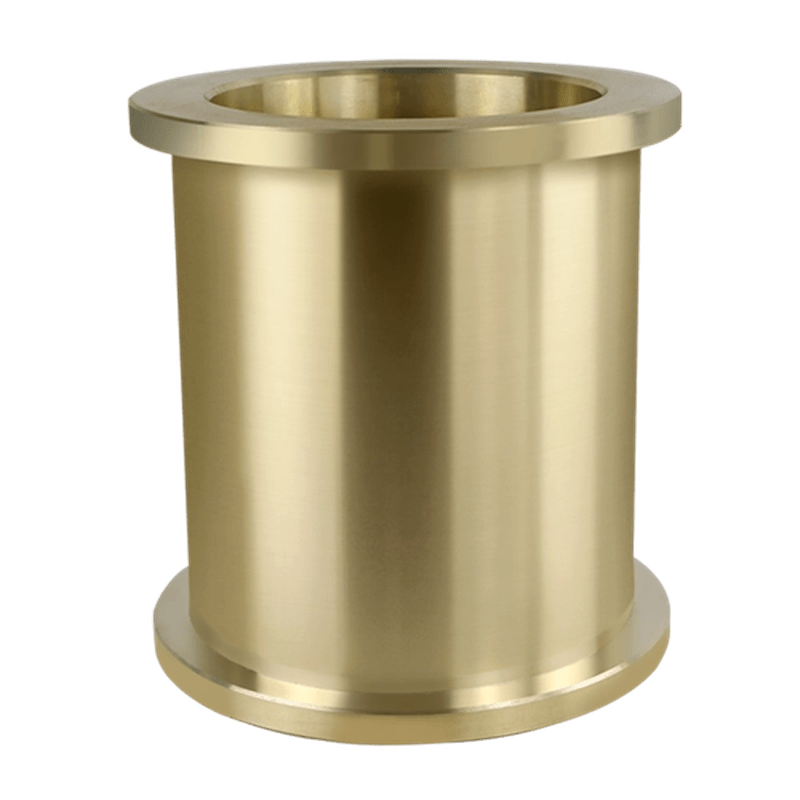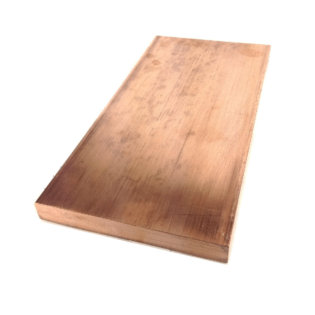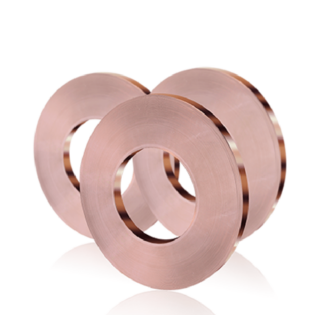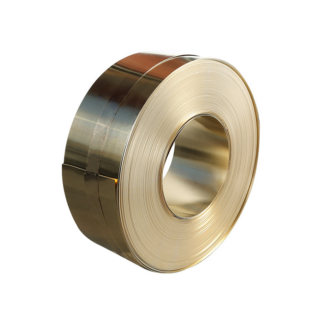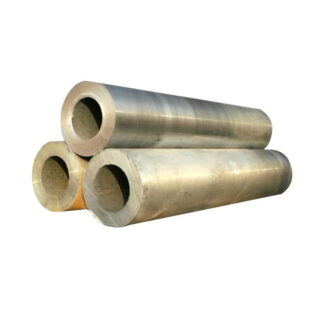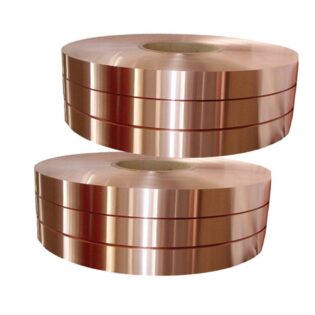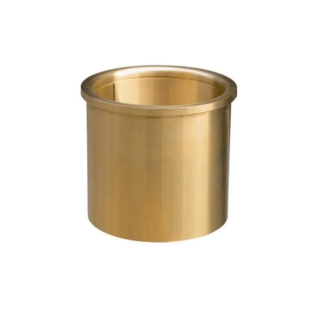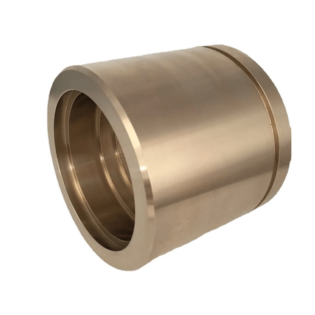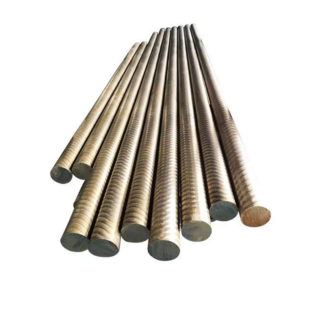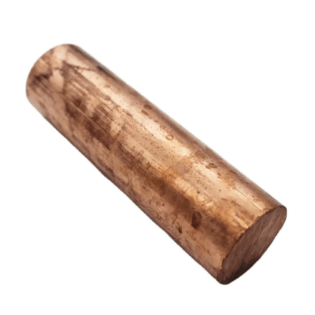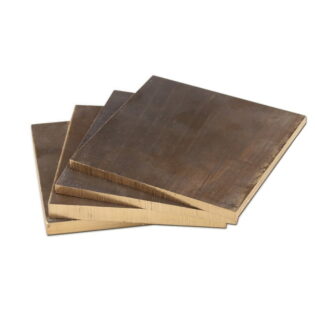AMS 4880-C95510 Nickel Aluminium Bronze Product Wprowadzenie
Skład chemiczny
| Element | Procent (%) | Rola w stopie |
|---|
| Cu | 78,00 min | Pierwotny składnik, zapewnia strukturę podstawową i właściwości |
| Sn | 00,20 maks | Poprawia odporność na korozję i siłę |
| Zn | 00,30 maks | Zwiększa siłę i działa jako deoksyzator |
| Fe | 2.00-3.50 | Udoskonalenia strukturę ziarna i zwiększa siłę |
| W | 4,50-5,50 | Poprawia odporność na korozję i właściwości mechaniczne |
| Glin | 9.70-10.90 | Tworzy związki międzymetaliczne, zwiększając wytrzymałość i odporność na zużycie |
| Mn | 1,50 maks | Poprawia siłę i odtlenia stop |
Uwaga: Cu + suma nazwanych elementów, 99,8% min. Wartość Ni obejmuje Co., chyba że zaznaczono inaczej, pojedyncze wartości reprezentują maksimum.
Właściwości mechaniczne
| Nieruchomość | Odlewy <4,0, poddane obróbce cieplnej | Odlewy 4.0+, poddane obróbce cieplne |
|---|
| Wytrzymałość na rozciąganie, min | 105,0 ksi (724 MPa) | 95,0 ksi (655 MPa) |
| Granica plastyczności (przesunięcie 0,2%), min | 62,5 ksi (431 MPa) | 56,0 ksi (386 MPa) |
| Wydłużenie w 4D, min | 9% | 9% |
| Twardość Brinella | 192 do 248 BHN | 192 do 248 BHN |
Wydajność w różnych temperaturach
| Zakres temperatur | Charakterystyka wydajności |
|---|
| Niskie temperatury (-50 ° C do 0 ° C) | Utrzymuje dobrą plastyczność i wytrzymałość |
| Temperatura pokojowa (od 20 ° C do 25 ° C) | Optymalna równowaga siły i plastyczności |
| Umiarkowane temperatury (100 ° C do 200 ° C) | Zachowuje dobrą twardość i odporność na zużycie |
| Podwyższone temperatury (200 ° C do 300 ° C) | Niewielki spadek siły, ale utrzymuje dobrą odporność na korozję |
| Wysokie temperatury (300 ° C do 400 ° C) | Zmniejszone właściwości mechaniczne, ale nadal użyteczne w niektórych aplikacjach |
Zastosowania branżowe
| Sektor przemysłowy | Określone aplikacje |
|---|
| Przemysł lotniczy | Tuleje zębatkowe, łożyska w strukturach samolotów |
| Morski | Śmigła, przeszkody pompy, komponenty zaworów w systemach wody morskiej |
| Ropa i Gaz | Komponenty platformy offshore, sprzęt podmorski |
| Automobilowy | Tuleje w systemach zawieszenia, komponenty skrzyni biegów |
| Maszyny Przemysłowe | Nosić talerze, tuleje w ciężkich maszynach |
| Górnictwo | Komponenty pompy, części systemu przenośników |
| Wytwarzanie energii | Komponenty turbinowe, siedzenia zaworów w elektrowniach |
Dostępność kształtu i rozmiaru
| Formularz | Zakres rozmiarów | Uwagi |
|---|
| Solidki | 1/2 ″ do 9 ″ O.D. | – |
| Rury | 1 1/8 ″ do 13 ″ O.D. | Skonsultuj się z młynem na grubość ściany |
| Prostokąty | Do 15 ″ | – |
| Standardowe długości | 24 ″ | Skonsultuj się z młynem na inne długości |
| Zapas baru | Różne średnice | Dostępne w okrągłym, sześciokątnym i kwadratowym kształcie |
| Płyta | Do 6 ″ grubości | Szerokość i długość różnią się w zależności od grubości |
| Odkuwki | Rozmiary niestandardowe | Zamówienie na podstawie specyfikacji |
Standardy produkcyjne
| Standard | Opis |
|---|
| AMS 4880 | Specyfikacja materiału lotniczego dla niklu aluminiowego brązu |
| ASTM B150 | Standardowa specyfikacja aluminium brązowego, pręta i kształtów |
| ASTM B171 | Standardowa specyfikacja płyty i arkusza miedzi-ściany dla naczyń ciśnieniowych, skraplaczy i wymienników ciepła |
| SAE J461 | Rurka wymiennika ciepła kutego miedzi i miedzi |
| MIL-B-21230 | Specyfikacja wojskowa dla brązu, aluminium |
Standardy i odpowiednie oceny w różnych krajach
| Kraj/region | Standard/klasa | Równoważne oznaczenie |
|---|
| USA | AMS 4880-C95510 | US C95510 |
| Europa | I 1982-CC333G | CuAl10Ni5Fe4 |
| Japonia | On H5120-CAC703 | – |
| Chiny | GB/T 5231-QAL9-4 | – |
| Rosja | GOST 493-79 klasa BRA9ZH4N4 | – |
| Indie | To 3091 klasa 2 | – |
| Australia | Jako 2074-CA953 | – |
Spawanie, przetwarzanie, polerowanie, obróbka cieplna, przetwarzanie zimna
Spawalniczy
| Metoda spawania | Stosowność | Uwagi |
|---|
| Spawanie łuku z gazem (GAW/TI) | Doskonały | Preferowana metoda spawów wysokiej jakości |
| Spawanie łuku metalu gazowego (GMAW/MIG) | Dobrze | Odpowiednie dla większych komponentów |
| Spawanie łukiem metalowym w osłonie (SMAW) | Sprawiedliwy | Może być używane, ale nie preferowane |
| Spawanie wiązki elektronów | Doskonały | Do precyzyjnego spawania w zastosowaniach lotniczych |
| Spawanie zamieszania tarcia | Dobrze | Pojawiająca się metoda dołączania do stanu stałego |
Przetwarzanie
| Metoda przetwarzania | Ocena obrabialności | Uwagi |
|---|
| Obrócenie | 50 (skala 0-100) | Użyj narzędzi do węglików, aby uzyskać najlepsze wyniki |
| Przemiał | 50 (skala 0-100) | Zalecane umiarkowane prędkości cięcia |
| Wiercenie | 50 (skala 0-100) | Używaj szybkich ćwiczeń stali lub węglików |
| Szlifowanie | Dobrze | Odpowiednie do osiągnięcia ciasnych tolerancji |
| Obróbka elektryczna (EDM) | Doskonały | Dla złożonych kształtów i profili |
Polerowanie
| Metoda polerowania | Wykończenie możliwe do osiągnięcia | Uwagi |
|---|
| Polerowanie mechaniczne | Wykończenie lustra | Używaj stopniowo drobniejszych materiałów ściernych |
| Elektropolerowanie | Wysoki połysk | Nadaje się do złożonych geometrii |
| Polerowanie | Wysoki połysk | Ostatni krok dla aplikacji dekoracyjnych |
Obróbka cieplna
| Proces obróbki cieplnej | Zakres temperatur | Zamiar |
|---|
| Wyżarzanie rozwiązania | 870-900 ° C. | Homogenizuj mikrostrukturę |
| hartowanie | Szybkie chłodzenie do temperatury pokojowej | Zwiększ siłę i twardość |
| Starzenie się | 350-400 ° C przez 2-4 godziny | Popraw właściwości mechaniczne |
| Odprężające | 350-400 ° C przez 1-2 godziny | Zmniejsz naprężenia wewnętrzne |
Obróbka na zimno
| Metoda przetwarzania zimnego | Wpływ na materiał | Aplikacje |
|---|
| Walcowanie na zimno | Zwiększa siłę i twardość | Produkcja arkusza i pasków |
| Rysunek na zimno | Poprawia wykończenie powierzchni i dokładność wymiarową | Produkcja drutu i rur |
| Kucie na zimno | Zwiększa właściwości mechaniczne | Komponenty kształtu w pobliżu sieci |
Zalety i wady materiałów
Zalety
| Korzyść | Opis |
|---|
| Wysoka wytrzymałość | Doskonała na rozciąganie i granica plastyczności w porównaniu z wieloma innymi stopami miedzi |
| Odporność na zużycie | Doskonała odporność na ścieranie i wściekłość |
| Odporność na korozję | Dobra odporność na wodę morską i wiele chemikaliów |
| Przewodność cieplna | Lepsze niż stale nierdzewne, odpowiednie do zastosowań wymiany ciepła |
| Nieiskrzący | Bezpieczny do użytku w środowiskach wybuchowych |
| Niska przepuszczalność magnetyczna | Odpowiednie do zastosowań wymagających materiałów niemagnetycznych |
Niedogodności
| Niekorzyść | Opis |
|---|
| Koszt | Droższe niż prostsze stopy miedziane lub stale |
| Waga | Cięższe niż stopy aluminium, które mogą stanowić problem w niektórych aplikacjach |
| Złożone przetwarzanie | Wymaga starannej kontroli podczas odlewania i obróbki cieplnej |
| Ograniczona plastyczność | Mniej plastyczne niż czyste miedź lub inne stopy miedzi |
| Potencjał pękania korozji naprężeń | Może wystąpić w określonych warunkach środowiskowych |
Podobne produkty i porównanie
Podobne stopi brązu nikiel aluminiowe
| Oznaczenie stopu | Skład chemiczny | Kluczowe różnice |
|---|
| C95800 | CU-9AL-4FE-4NI | Wyższa zawartość żelaza, nieco niższa wytrzymałość |
| C95700 | Z 11al-3fe-5ni | Wyższa zawartość aluminium, zwiększona twardość |
| C95400 | Z 11al-4fe | Brak niklu, niższy odporność na korozję |
Porównanie z innymi klasami materiałów
| Materiał | Zalety w stosunku do C95510 | Wady w porównaniu do C95510 |
|---|
| Stal nierdzewna 316 | Niższy koszt, wyższa dostępność | Niższe przewodnictwo cieplne, wyższa waga |
| Aluminiowy brąz (np. C95400) | Niższy koszt, łatwiejszy do obsadzenia | Niższa wytrzymałość i odporność na korozję |
| Brąz fosforowy | Lepsza przewodność elektryczna | Niższa wytrzymałość i odporność na zużycie |
| Stopy tytanu | Niższa gęstość, wyższy stosunek wytrzymałości do masy | Znacznie wyższy koszt, trudniej |
Szczegółowa tabela porównawcza
| Nieruchomość | AMS 4880-C95510 | Stal nierdzewna 316 | Aluminiowy brąz C95400 | Tytan klasy 5 (Ti-6Al-4V) |
|---|
| Wytrzymałość na rozciąganie (MPa) | 655-724 | 515-690 | 586-758 | 895-930 |
| Granica plastyczności (MPa) | 386-431 | 205-310 | 241-379 | 828-910 |
| Wydłużenie (%) | 9 (min) | 40 | 12 | 10-15 |
| Gęstość (g/cm3) | 7.64 | 8.00 | 7.45 | 4,43 |
| Przewodność cieplna (w/m · k) | 42 | 16.3 | 59 | 6.7 |
| Odporność na korozję w wodzie morskiej | Doskonały | Doskonały | Dobrze | Doskonały |
| Maszyna (skala 0-100) | 50 | 50 | 60 | 30 |
| Koszt względny | Wysoki | Umiarkowany | Umiarkowany | Bardzo wysoki |
Dodatkowe właściwości i cechy
| Nieruchomość | Wartość | Jednostki |
|---|
| Rezystancja | 14.4 | µΩ·cm |
| Specyficzna pojemność cieplna | 00,375 | J/G · ° C. |
| Zakres topnienia | 1030-1060 | °C |
| Moduł sprężystości | 110-120 | GPa |
| Współczynnik Poissona | 00,33 | – |
| Siła zmęczenia (10⁷ cykli) | 207-241 | MPa |
| Zdolność tłumienia | Umiarkowany | – |
Rozważania dotyczące środowiska i recyklingu
| Aspekt | Opis |
|---|
| Możliwość recyklingu | Wysoce nadające się do recyklingu, można go przypomnieć i ponownie wykorzystywał |
| Wpływ na środowisko | Niższe zapotrzebowanie na recykling w porównaniu do produkcji pierwotnej |
| Toksyczność | Nietoksyczne w postaci stałej, ale kurz i opary podczas przetwarzania powinny być kontrolowane |
| Koniec życia | Można zbierać i poddać recyklingowi za pomocą ustalonych strumieni recyklingu metalu |
Metody kontroli jakości i testowania
| Metoda badania | Zamiar | Standard |
|---|
| Testowanie na rozciąganie | Określić siłę i ciągliwość | ASTM E8 |
| Testowanie twardości | Zmierzyć twardość powierzchni | ASTM E10 (Brinell) |
| Analiza chemiczna | Sprawdź kompozycję | ASTM E478 |
| Badania ultradźwiękowe | Wykryj defekty wewnętrzne | ASTM E114 |
| Badania radiograficzne | Sprawdź pod kątem porowatości i inkluzji | ASTM E1742 |
| Testowanie korozji | Oceń odporność na korozję | ASTM G31 |
Zalecenia dotyczące przechowywania i obsługi
| Aspekt | Zalecenie |
|---|
| Środowisko przechowywania | Suchy, czysty obszar z dala od chemikaliów |
| Obsługiwanie | Użyj odpowiedniego sprzętu do podnoszenia ciężkich elementów |
| Ochrona | Nałóż powłoki ochronne lub opakowania, aby zapobiec uszkodzeniu powierzchni |
| Zarządzanie zapasami | Użyj systemu FIFO (pierwszy w, pierwszym), aby zarządzać zapasami |
| Środki ostrożności bezpieczeństwa | Noś odpowiednią środki ochrony środków ochrony środków podczas obsługi, szczególnie podczas cięcia lub obróbki |
Typowe czasy realizacji i czynniki cenowe
| Czynnik | Opis |
|---|
| Standardowe rozmiary zapasów | Zwykle dostępny z 1-2 tygodniem czasu realizacji |
| Niestandardowe rozmiary/kształty | Może wymagać 4-8 tygodni czasu realizacji |
| Ilość | Większe zamówienia mogą mieć dłuższe czasy realizacji, ale lepsze ceny |
| Warunki rynkowe | Ceny miedzi i niklu mogą znacząco wpłynąć na koszt końcowy |
| Wymagania certyfikacyjne | Specjalne certyfikaty mogą zwiększyć czas realizacji i koszty |
Wniosek
AMS 4880-C95510 Nickel Aluminium Bronze to wysokowydajny stop, który oferuje doskonałą kombinację wytrzymałości, odporności na zużycie i odporności na korozję. Jego wszechstronność sprawia, że nadaje się do szerokiej gamy zastosowań w różnych branżach, szczególnie w środowiskach morskich i lotniczych. Chociaż może mieć wyższy koszt początkowy w porównaniu z niektórymi innymi materiałami, jego długoterminowa wydajność i trwałość często powodują niższe koszty cyklu życia krytycznych komponentów. Zdolność materiału do utrzymywania swoich nieruchomości w różnych warunkach pracy, w połączeniu z jego charakterystyką nie do zapisania, sprawia, że preferowanym wyborem dla zastosowań krytycznych w zakresie bezpieczeństwa. Podobnie jak w przypadku każdego specjalistycznego materiału, należy podać właściwe rozważenie do projektowania, przetwarzania i konserwacji w celu pełnego wykorzystania jego możliwości i zapewnienia optymalnej wydajności przez cały okres użytkowania.

